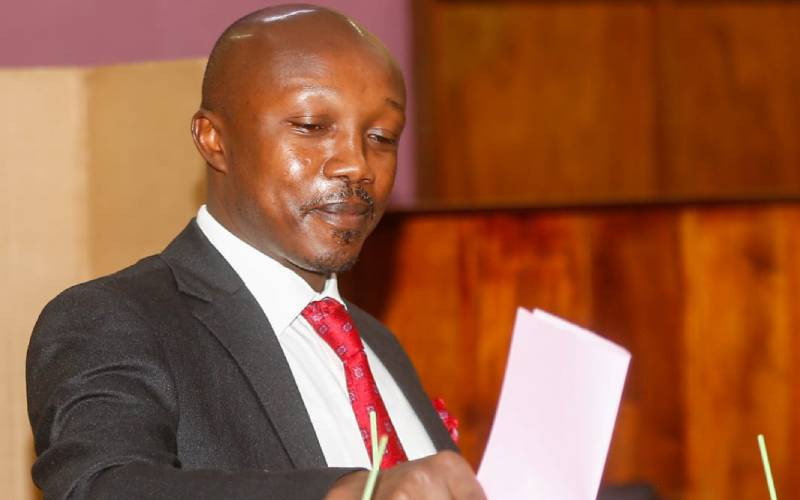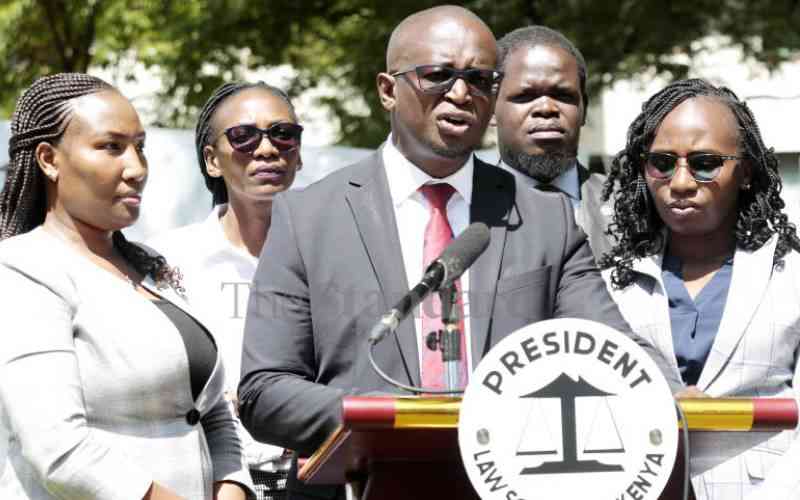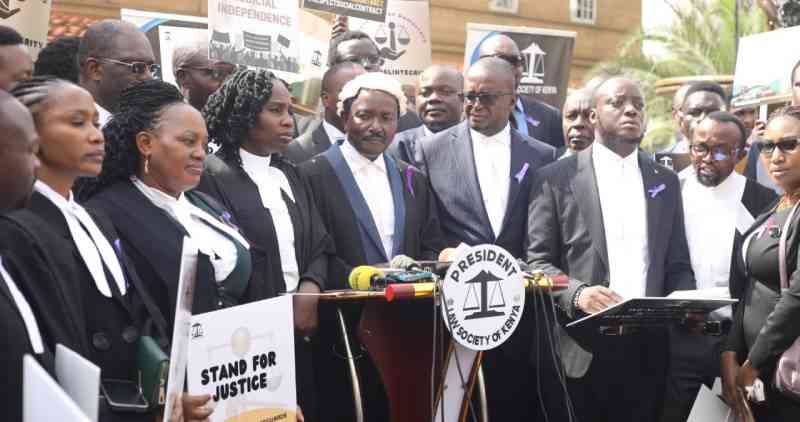On average, almost every week the media features reports on countless cases highlighting rising incidents of uniformed forces impunity. It is a case of duly enlisted law enforcers turning into rogue officers and vicious law breakers.
A case in point is the ongoing investigations into the brutal torture and bludgeoning to death of Willie Kimani – a lawyer and ardent human rights campaigner against police –, his client motorcycle rider Josephat Mwenda and hired taxi driver Joseph Muiruri.
Their bodies, pulled from a river situated several kilometres away from the scene of their abduction, bore multiple injuries. Besides the incident dominating news headlines, anti-police brutality activists sustained days of peaceful protests in Nairobi and other towns.
Of significant note were the hundreds of lawyers, all wearing purple ribbons in solidarity with their fallen colleague, marching to police headquarters to demand action.
The lawyers affiliated to the Law Society of Kenya maintained a week-long go-slow, crippling day-to-day court cases countrywide. They also filed an application seeking express orders that will bind and compel the police not to interfere with investigations into the killings.
Witnesses being intimidated to pull out of court appearances is rampant. This was incidentally the case with Mwenda – who defied threats and opted to pursue charges against an Administration Police officer attached to Syokimau Police Station who had shot him in an unprovoked incident in 2015.
The LSK's insistence on a court order is no doubt informed by the scuttling of previous cases implicating the law enforcers. In some instances crucial evidence and court files go ‘missing’ resulting in eventual dismissal or collapse of many cases. The bulk of these have revolved around extrajudicial police killings or arrested suspects’ disappearance from custody, some without trace.
Estimates attributed to the human rights group, Independent Medico Legal Unit indicate that some 520 extrajudicial killings have reportedly occurred since 2013. There are, however, pockets of unconfirmed dissenting voices which insist these figures are modest and in reality the number of victims is possibly higher.
Indeed, extrajudicial killings and assaults are a challenge that many countries face and the trend is by no means new to Kenya. Take the case of the US, which many countries benchmark against. During 2015, at least 1,134 deaths were recorded courtesy of law enforcement officers. In 2012, there were 312 killings of unarmed black Americans.
Six years ago, seven unarmed taxi drivers in Kawangware were killed by Administration Police officers on patrol. And after the case went to court, somehow, of course with the help of a lawyer, the officers managed to convince the Supreme Court that they had shot the unarmed taxi men in self-defence.
The APs in this case were acquitted after the Supreme Court overturned an earlier High Court ruling establishing they had a case to answer.
In the words of Justice Ochieng J., “I can only conclude that the story about the alleged superior fire power on the part of the victims is nothing more than a figment in the imagination of the accused persons.
It was a story calculated to justify the use of the firearms which the accused persons had. I find the indiscriminate shooting by the accused persons to constitute reckless use of firearms.”
But whereas that case faded into oblivion, I’m concerned about the recent solidarity shown by our lawyers against the backdrop of more riveting cases of police officers excessive use of force. While I am in no way trying to trivialise the magnitude and import of their gesture of unified support, I find the reaction and the attention somewhat disproportionate and a bit over the top.
It is no hidden secret that our country is littered with unresolved cases of police injustices. For instance, it is not strange that lawyers, who had no qualms representing the APs in 2010, are now complaining when one of their own represents those involved in Willie’s murder.
Stay informed. Subscribe to our newsletter
These disturbing murders have riveted the country with many wondering what they can do to help. However, this on-going case notably compelled the LSK, for the first time to take to the streets, thanks for showcasing what non-violent demonstrations are all about.
However, there is also the very disturbing case of another AP who was caught raping a 12-year-old minor and the repeat assaults and kidnappings of 19-year-old Daisy Karimi.
Are there any lawyers who are keep on pursuing the matter or offering say pro bono services for these two innocents? These are not isolated cases. How can Kenyans challenge narratives of police when these law enforcers are caught red-handed but somehow with the help of some prosecutors within their ranks manage to cover their acts by victimising the poor victims?
If the police force is doing poorly it’s not for lack of reforms within the regular police and administration police forces.
It is crucial that existing oversight entities i.e Office of Ombudsman, Kituo Cha Sheria, IPOA, National Task Force on Police and KHRC pool their resources to stem the rising tide of police brutality and extrajudicial killings.
 The Standard Group Plc is a
multi-media organization with investments in media platforms spanning newspaper
print operations, television, radio broadcasting, digital and online services. The
Standard Group is recognized as a leading multi-media house in Kenya with a key
influence in matters of national and international interest.
The Standard Group Plc is a
multi-media organization with investments in media platforms spanning newspaper
print operations, television, radio broadcasting, digital and online services. The
Standard Group is recognized as a leading multi-media house in Kenya with a key
influence in matters of national and international interest.
 The Standard Group Plc is a
multi-media organization with investments in media platforms spanning newspaper
print operations, television, radio broadcasting, digital and online services. The
Standard Group is recognized as a leading multi-media house in Kenya with a key
influence in matters of national and international interest.
The Standard Group Plc is a
multi-media organization with investments in media platforms spanning newspaper
print operations, television, radio broadcasting, digital and online services. The
Standard Group is recognized as a leading multi-media house in Kenya with a key
influence in matters of national and international interest.








